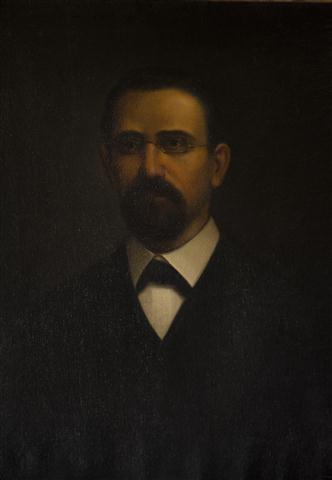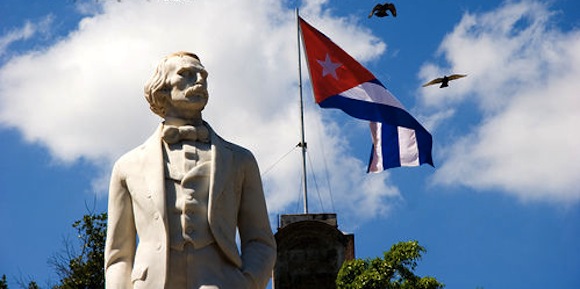Eusebio Leal Spengler ~ Historiador de la Ciudad de La Habana ~
500th Anniversary of the Founding of the First Town of our Lady of the Assumption of Baracoa
I have been particularly privileged to accompany the Vice President of the State Council, comrade Esteban Lazo, government ministers, the First Secretary of the Party, the Speaker of Parliament, deputies and the group of intellectuals and important figures who have come from Havana and on behalf of our Nation to accompany the Bishop of Guantánamo and Baracoa, the honorable prelates, presiding Primate Archbishop of Santiago de Cuba and Chair of the Episcopal Conference, as well as the National Monument Committee members, who have given me the task of addressing you on this occasion.
First of all, I would like to say this: for a moment, the rising of the sun over the eastern side of Cuba has stopped to allow us to perform the beautiful ceremony we have been summoned to do on this celebration.
During our trip this morning, I have been thinking about the special meaning of this celebration, mention of which should not be omitted or avoided. In fact, at the Solemn Assembly that will take place tonight I will have the chance, for the second time in a decade, to speak a little about what that history means, at the invitation of my dear and admired colleague Alejandro Hartman, who is also chief historian.
I would like to say that at the time when the Cross of Parra is placed on the altar, we shall be attending a historic ceremony of the utmost importance. Over 500 years ago, on 27 November 1492, the Admiral’s diary notes, meticulously recorded, revealed his astonishment at Baracoa’s incomparable beauty.
I understand and identify with his feelings. If today, when flying over the coast in the early morning light, we watched the beauty of those mountains, the river mouth and its unique features, the wonders of the horizon and Yunque mountain, we could then understand the significance of what occurred many years after the praises were sung of Baracoa’s palm groves and pine forests, of its’ bay formed in the shape of small broom, and the Yunque, which seems to be a work of human ingenuity rather than that of nature.
It is necessary to disregard Christopher Columbus’ opinion, on his last voyage, that the island, very close to its eastern end, was part of an inhospitable continent. He looked at it from the south and not as an island, as it had been originally conceived, giving it the lovely name of Juana, in honour of a prince who did not enjoy a long life. The name of Cuba, however, was tenaciously remembered. So strong was that impression, that in the raft which he found in the waters of the Caribbean Sea, someone repeated the short and sonorous name of Cuba to them. In fact, Cuba was a beautiful archipelago made up of hundreds of small islands and islets, of which the main and most beautiful one was Cuba.
In the lovely performance we have just attended, there were those naive people who dwelled in the area. The great Crown’s chronicler Pedro Martin did not hesitate to state that there was no ‘this-is-mine’ and ‘this-is-yours’ mentality amongst them, which is the cause of every evil. He clearly referred to the naive way the Eastern peoples lived, which still remained in those years when waves of them arrived on the island of Cuba.
A small chain of islands rises like a string of pearls from continental coasts – or rather descends to the Antilles – until it finally reaches the main island, and not far from here, in Maisí, the end of this chain signals the other large island that would be named Hispaniola by the Admiral. Here, the first settlement – La Navidad (“Christmas”) Fort – would be built using the remains of one of his wrecked ships.
It has been rightly said that several crosses were planted throughout the territory. With his return voyage, rather than his departure, an old conception of the world was falling apart – Ptolemy’s thinking, and that of the ancients, was superseded by what Copernicus and Galileo had imagined to be true.
In his hand, Columbus carried the Holy Scriptures, and the testimonies of Marco Polo and eastern travellers. In fact, he believed that he had not arrived in the eastern side of an island, but rather the eastern side of the Far East, which was his goal. We were taught at school that he was looking for a shorter route to India. Attempts to find the Great Khan’s representatives opposite Bariai or in the wonderful area of Holguín on the Atlantic coast were futile. Nobody responded to such demand, the native peoples rather hiding themselves in fear of what meeting with such strange and different creatures would mean.
Today, in order to avoid repetition of this story, I would like to say that amongst you, I see a varied display of the nuances of all peoples. We are like a miniature humankind – a portrait of the world. Ahead of us there are brightened eyes, darker complexions, hair like Damascus sables that Martí talked about, and straight hair that made Columbus think that, because of their dark complexion and hair quality, those in Cuba looked like people from the Canary Islands, which had also been recently subjugated to the Spanish Crown.
From that encounter, as painful as any with the unknown may be, a new and great reality emerged: us. Without that event, this ceremony could not be held; it would be a different one. We were also left with a powerful means of communication that would be put before blood itself: the language we speak, the Castilian language that we call Spanish.
In the art performance, they spoke about San Antonio María Claret; but some centuries before Claret was Archbishop of Santiago de Cuba, precisely in that expedition landing in Baracoa, there came a Dominican friar from Seville whose name seems to remain on Baracoa’s coat of arms, in whose first division there is a dog carrying a torch in its mouth with which it would light up the world. He was a Dominican who raised his voice in favor of native Indians, indigenous people in Hispaniola and Santo Domingo, and it was here in Trinidad – another town that will soon celebrate its 500th anniversary – where he was converted by renouncing the task he had been entrusted with, and showing an iron will to become what Martí described in The Golden Age as the Apostle he was: the apostle of native Indians, pale in the light of a candle, bent and old in his Chiapas Bishopric, telling a story full of all kinds of accounts and impressions.
The name Las Casas is still with us – one of the authors of modern humanism, who knew how to discuss the existence of an immortal soul in aborigines at the Valladolid debate, and who knew how to appeal to the Catholic Queen’s heart so she would have the laws re-written, which was the reason why he showed so much concern in his will. It lives on in The Baracoa Woman, sung by Cintio Vitier; and in the eminent leader Antonio Maceo who set foot on Duabas beach, not far from here.
Today we have gathered here in an act of concord, at a beautiful ceremony for, and in, our homeland, in the oldest of all cities in Cuba, at the foot of the statue of the Assumption. Today we have visited a Cathedral on which work has been passionately carried out. It is perhaps one of the last cathedrals being erected in this area. It is a Cathedral because the Bishop’s title is that of Guantánamo and Baracoa; it is therefore Baracoa’s right to be periodically its see, and as its see, it is also an episcopal see.
The Cross of Parra has been designated by the National Monument Committee as a National Monument and Treasure of the Cuban Nation. This is the result of an examination of its history, recognizing tradition as one of the sources, and provenance of the wood provided in studies by Mrs. Raquel Carreras, PhD. at the Belgian Forest Institute under special assignment from the Cuban National Heritage Council, which provided undeniable evidence of the age of the cross. The testimony of pastoral visits by Pedro Agustin Morel de Santa Cruz has also been recognized.
Compartir


